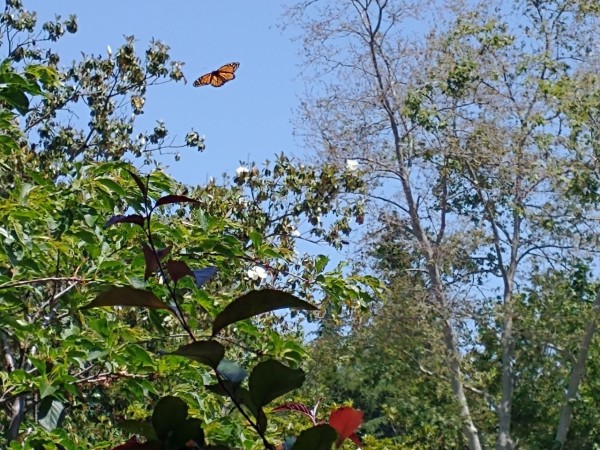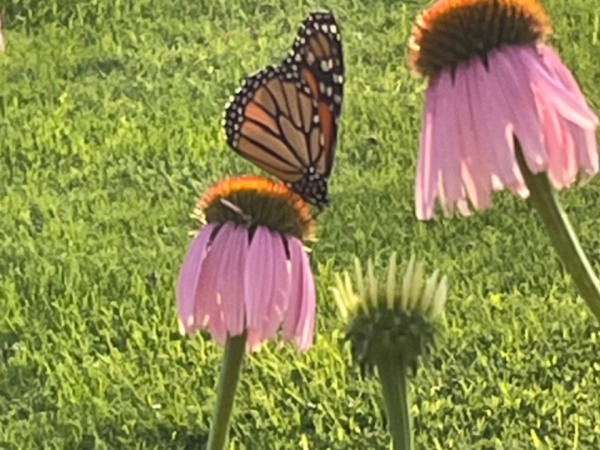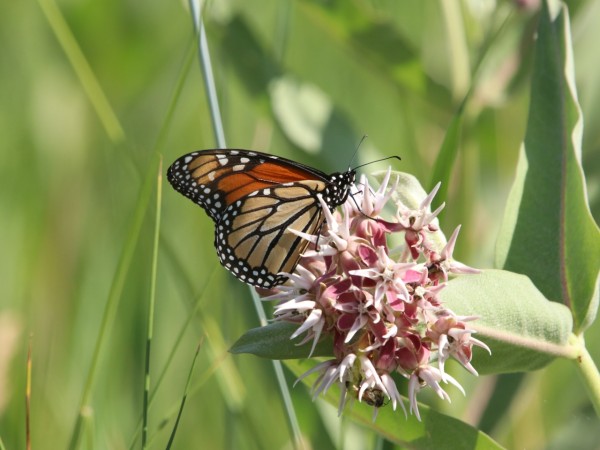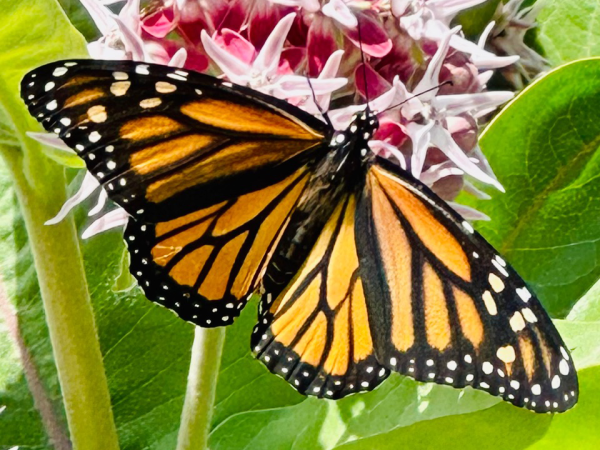Letter From Gail Morris: Western Monarch Spring 2023 Report #12
Western Monarchs Update
After several weeks of sparse reports, the Western states lit up with monarch first sightings reports all the way into Canada this week. A sigh of relief is in the air as monarchs now cover the entire West. The Summer Solstice is near and soon monarchs lose the urge to migrate and populate their breeding grounds, expanding their population when the weather is favorable.
Be sure to visit the Journey North maps to view the first arrivals of monarchs in your area.
First Monarch Sightings
Here is a sample of the large number of first monarch sightings and their photos, an exciting harbinger of the season.
On June 4, Joyce saw one monarch, “First monarch sighting in our garden! Male flying and nectaring on our Butterfly Bush.”
Laurie in Ashland, Oregon, reported on June 5, “I saw the first monarch of the season this morning and just saw another one right now at 5:30 Pacific standard time. I grow milkweed and have lots of it on my property."
On June 8, Jodi found her first monarch in inland California in Springville.
Loren saw her first monarch of the year in Kelowna, British Columbia, Canada on June 11! So far this is the most northern sighting in the West.
Also on June 11, Robin spotted the first monarch adult in Meridian, Idaho. “Yeah! The first monarch on the milkweed I grew just for them.”
From the Field
What are we hearing in the field? Mixed reports! Monarchs are appearing in some places, but are “missing in action” in others.
Huong reached out from California about his concerns. “I live in Oakland, California and every year, I look forward to the butterfly‘s return. This year, I am worried: Despite fabulous, healthy native milkweed in my garden, I have yet to see monarchs, eggs, or caterpillars. My son’s garden also has flowers and plenty of milkweed to no avail. It’s nearly June and it feels like my blooming garden is an empty house without the monarchs. Normally, they come fluttering in daily for nectar and egg laying in April. One piece of good news is from a friend who works at Google. There are some monarchs at their Mountain View campus, where Google established a monarch sanctuary.”
Mia Monroe shares, “San Francisco Bay Monitors (California) noted late emerging native milkweed but also the few monarchs that had made it through winter lingered longer than usual in the coastal zone. Mid-May reports came in, finally!, of hungry caterpillars at Marin school gardens, the Marin Art and Garden Center and in May at a newly planted pollinator garden at the Fairfax library: 1 egg! Purple milkweed is robust this year in Sierra foothills so hopefully the anticipated warm spell mid-June will encourage inland dispersal of monarchs to rebuild the population!”
Dr. David James of Monarchs of the Pacific Northwest in Washington is surprised. So far, he has received about the same number of monarch reports this year as he did last year in Oregon and Washington to date. But last year the monarch population exploded at the end of June. “Time will tell if this same population expansion occurs this year - or not.”
Dr. Tom Landis in Oregon is hearing of monarchs several blocks away in his neighborhood but so far hasn’t seen any at all in his yard. Tom is involved in extensive milkweed restoration work out in the field regularly seasonally.
Rachel Taylor in Salt Lake City, Utah, shares, “so far, we have sightings starting the last week of May through the first week of June: from Washington County at the very bottom of the state, and four additional counties: Juab, Utah, Salt Lake, and Davis. We seem to be at that lull between generations, but hopefully that will change soon.”
In Arizona, we haven’t heard of any monarch reports in the mid and higher elevations such as Prescott, Flagstaff, or Pinetop/Lakeside like we often do by June. But surprisingly, monarchs are appearing in Tucson in the Southeast part of the state. Usually by now monarchs leave the lower deserts as temperatures begin to reach 100+°. But Spring has featured cooler temperatures. We’ll have to see how the monarchs respond over the next few weeks.
Call for Reports!
Despite a much healthier overwintering monarch population, the key to the summer breeding season will be reflected in the progress of monarchs the next few weeks. Your reports are critical to our understanding of this season’s migration. We urgently need reports of sightings of emerging milkweeds and monarchs in any life-stage. Provide as much information as you can such as weather conditions (it’s okay to estimate). Your detailed description of what you see can include, but is not limited to, the monarch’s gender, wing condition (worn or excellent and everything in between), their type of activity and, if known, the type of milkweed, flower type if they are nectaring. Be sure to check milkweeds for eggs, larvae, or pupae if you are lucky to find them. We look forward to your reports!
Gail Morris is the Coordinator of the Southwest Monarch Study (www.swmonarchs.org), a Monarch Watch Conservation Specialist, and the Vice President of the Monarch Butterfly Fund, the Central Arizona Butterfly Association, and the Western Monarch Advocates. The Western Monarch Population News is based on comments provided to Gail Morris. We hope to increase the number of sightings and therefore photos and comments entered into Journey North. We rely on the volunteers who communicate regularly with Gail and who agree to participate in our effort to increase awareness of the population of Western Monarchs. You can reach Gail at gail@swmonarchs.org






